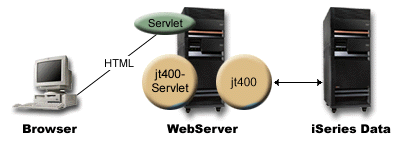The servlet classes that are provided with IBM® Toolbox for Java™ work with the access classes, which are located on the webserver, to give you access to information located on the iSeries™ server. You decide how to use the servlet classes to assist you with your own servlet projects.
The following diagram shows how the servlet classes work between the browser, webserver, and iSeries data. A browser connects to the webserver that is running the servlet. jt400Servlet.jar and jt400.jar files reside on the webserver because the servlet classes use some of the access classes to retrieve the data and the HTML classes to present the data. The webserver is connected to the iSeries server where the data is.
Figure 1: How servlets work
There are four types of servlet classes included with IBM Toolbox for Java:
- Authentication classes
- RowData classes
- RowMetaData classes
- Converter classes
Note: The jt400Servlet.jar file includes both the HTML and Servlet classes. You must update your CLASSPATH to point to both jt400Servlet.jar and jt400.jar if you want to use classes in the com.ibm.as400.util.html and com.ibm.as400.util.servlet packages.
For more information about servlets in general, see the reference section.

